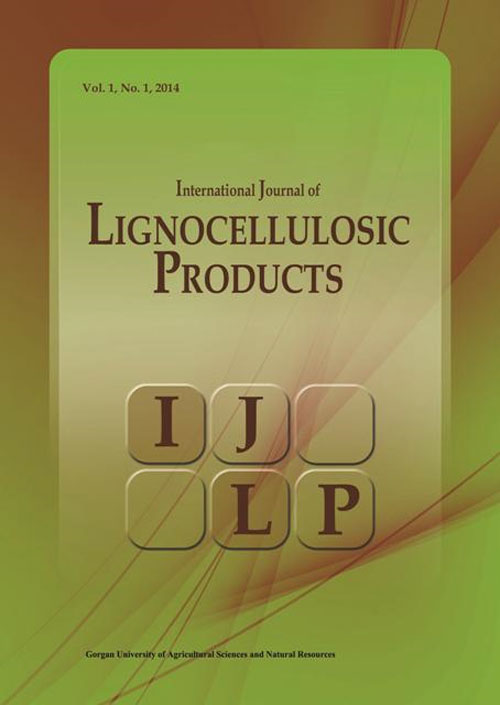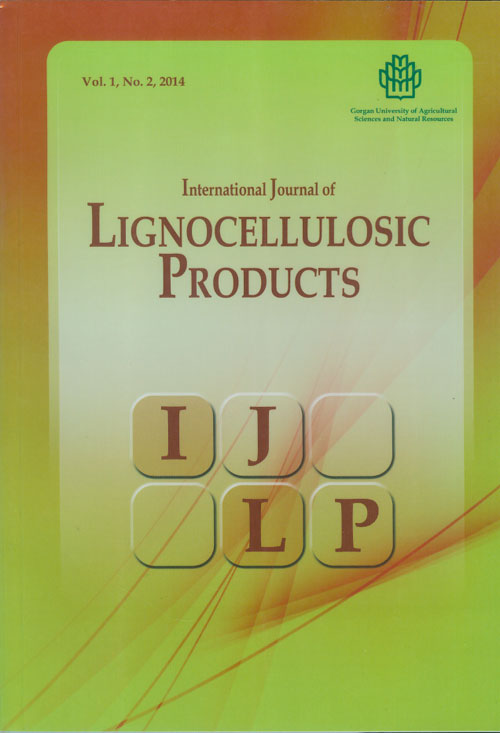فهرست مطالب

International Journal of Lignocellulosic Products
Volume:1 Issue: 1, 2014
- 102 صفحه،
- تاریخ انتشار: 1393/11/01
- تعداد عناوین: 7
-
Pages 1-27Wood is a porous three dimensional, hydroscopic, viscoelastic, anisotropic bio-polymer composite composed of an interconnecting matrix of cellulose, hemicelluloses and lignin with minor amounts of inorganic elements and organic extractives. Some, but not all, of the cell wall polymer hydroxyl groups are accessible to moisture and these accessible hydroxyls form hydrogen bonds with water. As the water layers build up, the cell wall expands to accommodate the water resulting in an increase in wood/water volume up to the fiber saturation point. Increased moisture levels also offer a large variety of micro-organisms the opportunity to colonize and begin the process of decay. If these accessible hydroxyl groups are chemically substituted with a larger and more hydrophobic chemical groups, the bonded chemical can expand the cell wall until it reaches its elastic limit. And if the hydrophobic nature of substituted groups sufficiently reduces the cell wall moisture levels, the wood will no longer support the colonization of micro-organisms. This modified wood then achieves a high level of dimensional stability and durability. One technology that has now been commercialized to achieve these properties is acetylation: a reaction between the hydroxyl groups on the wood cell wall polymers with acetic anhydride. While all woods contain a low level of acetyl groups, increasing this acetyl content changes the properties and performance of the reacted wood. When a substantial number of the accessible hydroxyl groups are acetylated consistently across the entire cell wall, the wood reaches its highest level of dimensional stability and durability.Keywords: Acetylation, Acetic anhydride, Brown, rot, Chemical modification, Decay resistance, ýDimensional stability, Equilibrium moisture content, Fiber saturation point, ýHardwoods, Mechanisms, Softwoods, Stiffness, Strength, Water soak, White, rot
-
Pages 28-38This work investigates the feasibility of using recycled high density polyethylene (rHDPE), recycled polypropylene (rPP) and old newsprint fiber (ONP) to manufacture fiber reinforced composites. The boards were made through air-forming and hot press. The effects of the fiber loading and coupling agent content on tensile, flexural, internal bond properties and water absorption and thickness swelling of wood-fiber plastic composites were studied. In general, the weight content of ONP is a key parameter that would substantially influence the physical and mechanical properties of the samples. The obtained results showed that the use of maleated polypropylene as coupling agent, improved the compatibility between the fiber and both plastic matrices, and mechanical properties of the resultant composites compared well with those of non-coupled ones. Based on the findings in this study, it appears that recycled materials can be used to manufacture value-added boards without having any significant adverse influence on board properties. It was also found that composites with rHDPE provided moderately superior properties, compared with rPP samples.Keywords: Coupling agent, Fiber reinforced composite, Mechanical properties, Old newsprint fiber. ý
-
Pages 39-49In this study, the effect of soluble chitosan, thyme oil and linseed oil on the mold resistance of wood and its surface properties was investigated. Both low and medium molecular weight chitosan with concentration of 1 and 2% were used. Cypress wood samples with dimensions of 20 × 20 × 70 mm and moisture content of 12% were saturated by the preservatives. The results showed that the maximum absorption was for linseed oil and the lowest one for low molecular weight chitosan with concentration of 2%. The lowest and highest leaching values were observed for the samples treated by linseed oil and medium molecular weight chitosan with concentration of 2%, respectively, but these differences do not seem to be statistically different. After 4 weeks, thyme essential oil was able to completely prevent mold growth. Compared to chitosan, linseed oil had a greater inhibitory effect to the growth of mold. Antifungal effect of chitosan was increased by increasing its molecular weight. In contrast to thyme oil and linseed oil, the wood treatment by chitosan increased its wettability. There was no significant difference between the roughness of control and treated samples.Keywords: Chitosan, Linseed oil, Mold resistance, Surface properties, Thyme oil.ý
-
Pages 50-57The use of agriculture residues as filler in composites is increasing due to their strength, abundance and low cost. Soya stalks show promising renewable natural fiber. In polyethylene composites the physical and mechanical properties (flexural resistance, tensile, impacted absorbed energy, water uptake and thickness swelling) was examined at different composites. The results showed that, the mechanical properties increased with soya stalk content However, the physical properties have tended to decrease.Keywords: Mechanical properties, Natural fibers, Soya stalk flour.ý
-
Pages 58-71In this research, the characteristics of CMP dioxane lignin (hardwood origin) and soda bagasse lignin (ethanol soluble fraction) and dioxane lignin of bagasse were studied using gel permeation chromatography, gas chromatography-mass spectrometry and 13C NMR spectroscopy and DFRC degradation procedure. The results indicated that the main structural units in lignins are phenyl propane skeletons bonded at β-O-4 positions.Keywords: Bagasse, Chromatography, CMP dioxane lignin, Derivatization followed by ýreductive cleavage (DFRC), Soda lignin, Spectroscopy.ý
-
Pages 72-81The medium density fiberboard (MDF) market demand was investigated during the years from 2004 to 2013 in Iran. Estimation of MDF demand was made by exponential smoothing method by the year 2018. The insight into the level of demand that might exist by the year 2013 was obtained by reviewing the production, import, export, and consumption of MDF on the Iran. The results show that the consumption of MDF has been risen by 4.7 times since 2004. The estimated demand for MDF in Iran shows that the total MDF demand will reach more than 1642000 m3 in the year 2018, which increases by 42% in comparison with that in 2013. By now, 61% of domestic MDF in Iran still relies on import while economic sanction effect on import ratio and business competitiveness among MDF manufactures in Iran especially in 2013. The estimated consumption of MDF in future provides a base for expanding the present demand in terms of its present level in Iran. According to our results, to encourage the continued development, the Iran MDF industries require a forestry program providing the raw material needed.Keywords: Exponential smoothing, Market, Medium Density Fiberboard.ý
-
Pages 82-92The objective of the article is to investigate the variability in growth and wood properties of the willow clones. The growth and wood traits of four year old 21 clones willow clones were investigated. Analysis of variance showed that willow clones differed significantly for all the studied growth and wood traits. Among the growth parameters the maximum heritability value was shown by height which was 0.92 (92%) and minimum of 0.59 (59%) was recorded for wood and bark percentage. The mean value of specific gravity is 0.76 (Heritability 0.69) and mean value of fiber length is 1.41 mm and value of heritability factor is 0.77. The value of heritability factor is high for alcohol-benzene extractive content (heritability value= 0.73). Wide range of variability was seen for all the physico-chemical characteristics of wood of promising willow clones. The values for phenotypic and genotypic coefficients of variability, heritability, genetic advance and genetic gain ranged between 2.51-35.63, 2.09-30.49, 24-92, 0.03-31.20 and 3.95-53.73%, respectively.Keywords: Chemical composition, Heritability, Physical properties, Variability, Willow clones. ý


